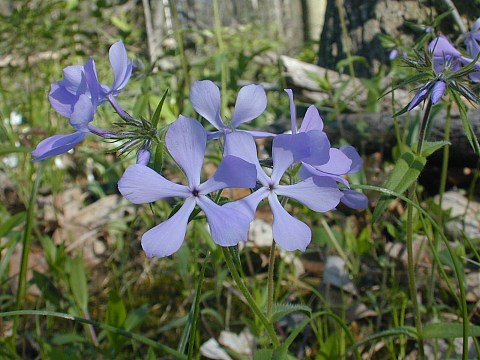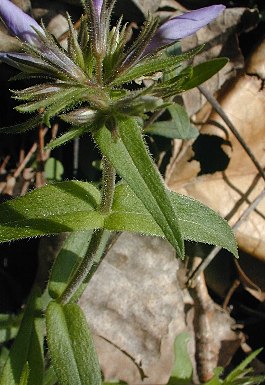Description: The fertile shoots of this herbaceous perennial plant are about 1–1½' tall and unbranched, except near the apex where the flowers occur. The central stem of each fertile shoot is light green to reddish brown and pubescent to hairy; some of these hairs are sticky-glandular. Occasionally, 1-2 short side stems are produced from the axils of the upper leaves. The opposite leaves of the fertile shoots are up to 2½" long and ¾" across; they are narrowly lanceolate to ovate and sparsely short-pubescent to hairy. The margins of the leaves are smooth and ciliate, while at the base they are sessile or clasp the stem. In addition to the fertile shoots, Woodland Phlox also produces infertile shoots that do not produce flowers. These infertile shoots have a similar appearance to the fertile shoots, except that their stems are somewhat shorter and their leaves tend to have more rounded tips.

Each
upper stem of a fertile shoot terminates in a cluster of flowers
spanning 2-3½" across. Each flower spans about 1" across. It
consists of a light blue-violet, lavender, or white corolla
with 5
spreading lobes that are fused together at its tubular base, and a
hairy green or reddish green calyx with 5 linear teeth. The throat of
the corolla is very narrow; the 5 stamens and pistil are inserted
within. The spreading lobes are narrow toward the throat of the
corolla, but become broader toward their tips (oblanceolate). For this
subspecies of Woodland Phlox (Phlox
divaricata laphamii),
the tips of these lobes are rounded or bluntly angular; they are never
deeply indented or cleft. The pedicels of the flowers are rather short
and hairy. The blooming period occurs from mid-spring to early summer
and lasts about a month. The floral scent is pleasantly sweet and
aromatic. Each flower is replaced by an ovoid seed capsule (4 mm. in
length) containing several small seeds. The root system produces
stolons that establish infertile shoots. Small colonies of clonal
plants are often formed by means of these stolons.
Cultivation:
The preference is light shade to partial sun, moist
to dry-mesic conditions, and a rich loamy soil with abundant
organic matter. The fertile shoots die down after seeds have been
produced, but the infertile shoots remain green for the remainder of
the growing season.
 Range
& Habitat:
This native subspecies of Woodland Phlox (Phlox divaricata laphamii)
is a common plant that occurs in nearly all counties of Illinois; it is
somewhat less common in the NW area of the state (see Distribution
Map). Habitats include moist to slightly dry deciduous
woodlands and areas along woodland paths. In young woodlands that have
sprung up where the original woodland was destroyed by plowing or heavy
construction, this species is usually absent. It can survive minor, but
not severe, degradation of woodland habitat. Removal or thinning of
dense stands of Sugar Maple saplings is beneficial because it improves
ambient light levels for the infertile shoots.
Range
& Habitat:
This native subspecies of Woodland Phlox (Phlox divaricata laphamii)
is a common plant that occurs in nearly all counties of Illinois; it is
somewhat less common in the NW area of the state (see Distribution
Map). Habitats include moist to slightly dry deciduous
woodlands and areas along woodland paths. In young woodlands that have
sprung up where the original woodland was destroyed by plowing or heavy
construction, this species is usually absent. It can survive minor, but
not severe, degradation of woodland habitat. Removal or thinning of
dense stands of Sugar Maple saplings is beneficial because it improves
ambient light levels for the infertile shoots.
Faunal Associations:
The flowers are pollinated by long-tongued bees (especially
bumblebees), bee flies, butterflies (especially swallowtails),
skippers, and moths (including Hummingbird Clearwing & Sphinx
moths). These insects suck nectar from the flowers. Some insects feed
on Phlox spp. (Phlox species), including Lopidea
davisi (Phlox Plant Bug; damages buds & flowers), Heliothis
phloxiphagus (Spotted Straw; caterpillars feed on flowers),
and Lacinipolia olivacea (Olive Arches;
caterpillars feed on foliage). The latter two species are moths. The
foliage of Woodland Phlox is browsed by various mammalian herbivores,
including rabbits, deer, and livestock.
Photographic Location:
Busey Woods in Urbana, Illinois. Woodland Phlox is usually found in
mesic areas of this deciduous woodland.
Comments:
The flowers of Woodland Phlox often have a wonderful fragrance and it
is a beautiful plant. Compared to other Phlox spp.
(Phlox species), the flowers of this subspecies of Woodland Phlox are
more
blue-violet and less pink in color. However, there is some variation in
the color of the flowers across different areas. This subspecies of
Woodland Phlox (Phlox
divaricata laphamii) has corolla lobes with
rounded or bluntly angular tips. In contrast, the typical subspecies of
Woodland Phlox (Phlox
divaricata divaricata) has corolla lobes with
shallowly notched tips. The corolla lobes of these subspecies are never
deeply cleft like those of Phlox bifida (Sand
Phlox). The leaves of Woodland Phlox are usually more broad than the
leaves of other Phlox species, especially those that prefer sunny
areas. This is also one of the few Phlox species that produces clumps
of infertile shoots. These infertile shoots store energy in the roots
for
the early production of next year's fertile shoots and flowers.